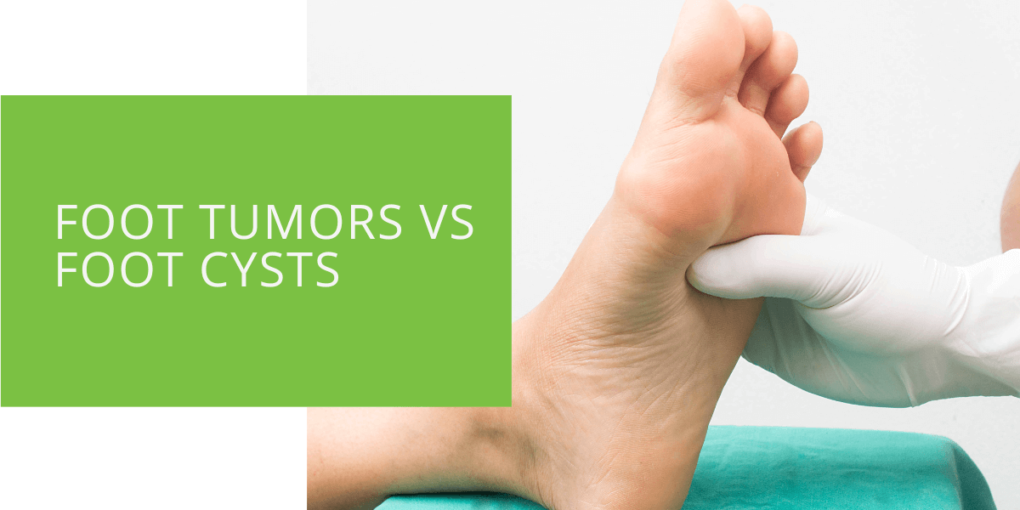Foot Tumors vs. Foot Cysts
The foot and ankle are complex structures that are susceptible to various conditions. Among these conditions are tumors and cysts, which can be benign or malignant. This article aims to explain the differences between foot tumors and cysts, including symptoms, diagnosis, and treatment options. Understanding the difference between these two conditions is important to seek the appropriate treatment and care for your foot.
Foot Tumors
A foot tumor is an abnormal growth of cells or tissue in the foot. These tumors can be benign or malignant. Benign tumors are non-cancerous and do not spread to other body parts, while malignant tumors are cancerous and can spread to other parts of the body.

Types of Foot Tumors
There are two main types of foot tumors: bone and soft tissue.
Bone Tumors: Bone tumors, also known as osteomas, develop in the foot's bones. They are typically benign and slow-growing. Common types of bone tumors include osteochondromas, osteoid osteomas, and enchondromas.
Soft Tissue Tumors: Soft tissue tumors, also known as sarcomas, are tumors that develop in the soft tissues of the foot, such as muscles, tendons, ligaments, and fat. These tumors can be benign or malignant. Common types of soft tissue tumors include lipomas, fibromas, and synovial sarcoma.
Symptoms of Foot Tumors
Symptoms of foot tumors can vary depending on the type and location of the tumor. Common symptoms include pain, swelling, and a lump or bump on the foot. In some cases, there may be no symptoms at all.
Diagnosis and Treatment of Foot Tumors
If you suspect you have a foot tumor, it is important to see a podiatrist or doctor specializing in treating foot and ankle conditions. They will perform a physical examination and may order imaging tests, such as an X-ray or MRI, to confirm the diagnosis.
The treatment of foot tumors depends on the type and location of the tumor and the patient's overall health. Benign tumors can often be treated with surgery to remove the tumor. Malignant tumors may require more extensive treatment, such as chemotherapy or radiation.
Foot Cysts
A foot cyst is a fluid-filled sac that develops on or in the foot. They can be benign or malignant.

Types of Foot Cysts
There are two main types of foot cysts: ganglion cysts and bursitis.
Ganglion Cysts: A ganglion cyst is a benign cyst that develops on the top or bottom of the foot. They are filled with clear, gel-like fluid and can vary in size.
Bursitis: Bursitis is a condition in which the fluid-filled sacs, known as bursae, cushion the joints and become inflamed. This can occur in the foot and ankle.
Symptoms of Foot Cysts
Symptoms of foot cysts can vary depending on the type and location of the cyst. Common symptoms include a lump or bump on the foot that may be tender to the touch, pain, and swelling. In some cases, there may be no symptoms at all.
Diagnosis and Treatment of Foot Cysts
If you suspect you have a foot cyst, it is important to see a podiatrist or doctor specializing in treating foot and ankle conditions. They will perform a physical examination and may order imaging tests, such as an X-ray or MRI, to confirm the diagnosis.
The treatment of foot cysts also depends on the type and location of the cyst. Ganglion cysts can often be treated with conservative measures, such as rest, ice, and physical therapy. In some cases, surgery may be necessary to remove the cyst. On the other hand, bursitis can be treated with rest, physical therapy, and anti-inflammatory medication.

Comparison of Foot Tumors and Foot Cysts
There are some similarities and differences between foot tumors and cysts. Both can present as a lump or bump on the foot, and both can cause pain and swelling. However, foot tumors are more likely to be malignant, while foot cysts are more likely to be benign. Additionally, foot tumors are more likely associated with pain at night and with activities such as walking or running. At the same time, cysts are more likely to be associated with pain at rest.
Prevention and Management
The best way to prevent foot tumors and cysts is to take good care of your feet. This includes regularly inspecting your feet for any changes, such as lumps or bumps, and consulting a podiatrist if you notice any unusual symptoms. It is also important to maintain a healthy lifestyle, which can help to reduce the risk of developing these conditions.
If you are experiencing symptoms of a foot tumor or cyst, it is important to seek treatment as soon as possible. Early diagnosis and treatment can help prevent the condition from worsening and improve the chances of a successful outcome.
Conclusion
In conclusion, foot tumors and cysts are two different conditions that require different treatments. Understanding the differences between these two conditions is important to seek the appropriate treatment and care for your foot. If you suspect you have a foot tumor or cyst, it is important to see a podiatrist or doctor specializing in treating foot and ankle conditions. To prevent the development of these conditions, it is important to take good care of your feet and maintain a healthy lifestyle. If you have any concerns about your foot or ankle, you must make an appointment with a specialist today.

